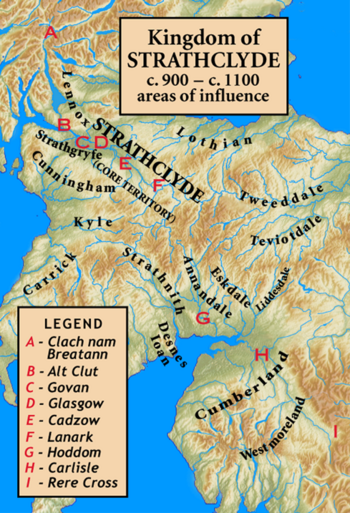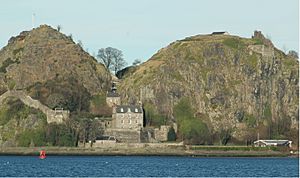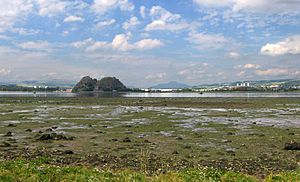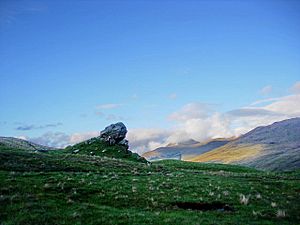Kingdom of Strathclyde facts for kids
Quick facts for kids
Kingdom of Strathclyde
Teyrnas Ystrad Clut
|
|||||||||
|---|---|---|---|---|---|---|---|---|---|
| 5th century–c. 1030 | |||||||||

The core of Strathclyde is the strath of the River Clyde. The major sites associated with the kingdom are shown, as is the marker Clach nam Breatann (English: Rock of the Britons), the probable northern extent of the kingdom at an early time. Other areas were added to or subtracted from the kingdom at different times.
|
|||||||||
| Capital | Dumbarton and Govan | ||||||||
| Common languages | Cumbric | ||||||||
| Government | Monarchy | ||||||||
| Historical era | Middle Ages | ||||||||
|
• Established
|
5th century | ||||||||
|
• Incorporated into the Kingdom of Scotland
|
c. 1030 | ||||||||
|
|||||||||
| Today part of | Scotland ∟ Dumfries and Galloway ∟ East Ayrshire ∟ North Ayrshire ∟ South Ayrshire ∟ South Lanarkshire ∟ North Lanarkshire ∟ East Renfrewshire ∟ Renfrewshire ∟ Glasgow City ∟ Inverclyde ∟ East Dunbartonshire ∟ West Dunbartonshire ∟ Argyll and Bute ∟ Stirling |
||||||||
Strathclyde was an ancient kingdom in what is now southern Scotland and northern England. Its name means "Strath of the River Clyde". The people of Strathclyde were Britons, similar to the Welsh. They spoke a language called Cumbric, which was like Old Welsh.
The kingdom started after the Roman Empire left Britain in the 5th century. Its main capital was Dumbarton, a strong fort known as Alt Clut (meaning "Rock of the Clyde"). Later, after a big Viking attack in 870, the center of the kingdom might have moved to Govan. Over time, Vikings and Norse-Gaels (people of mixed Norse and Gaelic heritage) also settled in the area. Eventually, in the 11th century, Strathclyde became part of the growing Kingdom of Scotland.
Contents
Where Was Strathclyde Located?


The exact borders of Strathclyde changed over time. It was mainly in the valley of the River Clyde. To the north, a place called Clach nam Breatann (meaning "Rock of the Britons") might have marked its edge. This rock is near Loch Lomond. The Campsie Fells and marshy areas near Stirling might have formed another border. To the south, the kingdom stretched along the Clyde valley and probably reached the coast near Ayr.
Before Strathclyde became a kingdom, the area was home to different tribes. One important tribe was the Damnonii, whose capital was thought to be near Dumbarton. The Romans built Hadrian's Wall as their northern border, but they also had forts further north, like at Cramond. Roman armies sometimes went even further north. People from these northern tribes also traveled south to trade or serve in the Roman army.
When the Romans left Britain around 410 AD, it probably didn't affect the Damnonii much militarily. However, it likely had a big economic impact because the Romans stopped paying the soldiers who guarded the wall.
Early History of Strathclyde
Historians don't have many written records from the early days of Strathclyde (400-600 AD). Most information comes from Irish and Welsh stories written much later.
One of the first known kings was Ceretic Guletic, who lived in the late 5th century. We know about him because Saint Patrick wrote a letter to him. This letter shows that Ceretic was a Christian, and it's likely that the leaders of Strathclyde were also Christians.
Another important king was Rhydderch Hael, a descendant of Ceretic. He lived around the same time as other powerful kings in northern Britain, like Áedán mac Gabráin of Dál Riata.
Christianity seems to have spread in southern Scotland early on. While Saint Columba is famous for spreading Christianity in other parts of Scotland, Saint Mungo is said to have brought it to the Britons of the Clyde. However, much of his story was written down much later, so it's harder to know the exact details.
The Kingdom of Alt Clut (Dumbarton)
After 600 AD, we start to get a bit more information about Alt Clut (Dumbarton). In 642, the Britons of Alt Clut, led by King Eugein, won a big battle against the Dál Riata people at Strathcarron. This was a significant victory for Alt Clut.
During the 8th century, the Pictish king Óengus tried to conquer Alt Clut several times, but he was never successful. In 750, the Picts suffered a major defeat against Alt Clut. In 756, Óengus and the Northumbrian king Eadberht of Northumbria attacked Dumbarton Rock. They managed to get the Alt Clut king, Dumnagual, to agree to their terms. However, this agreement didn't last long.
The Viking Age and Changes
A major event happened in 870 when a Viking army from Dublin, led by Amlaíb Conung and Ímar, attacked and captured Dumbarton Rock. The siege lasted four months. After taking the fort, the Vikings took many captives, including Angles, Britons, and Picts, back to Ireland.
After this attack, the name Strathclyde became more common, perhaps because the kingdom's center moved to Govan. The king of Strathclyde, Arthgal ap Dyfnwal, was killed in Dublin in 872. His son, Run of Alt Clut, then became king and married the sister of Causantín mac Cináeda, the king of Alba (Scotland).
From this time on, the kings of Alba often had some control over Strathclyde. Vikings and Norse-Gaels also settled in Strathclyde, leaving behind place names and monuments like the hogback graves at Govan.
In the early 10th century, Strathclyde formed an alliance with Scotland against the Vikings. The king of Strathclyde, Owain, was an ally of the Scottish king. In 937, Owain joined the Scottish and Viking forces in invading England, but they were defeated by the English king Æthelstan at the Battle of Brunanburh.
After this battle, Dyfnwal ab Owain became king. In 945, the English king Edmund I attacked Strathclyde. He then gave the kingdom to King Malcolm I of Scotland, but Dyfnwal soon got his kingdom back. He died in 975 while on a pilgrimage to Rome.
The End of Strathclyde
The Kingdom of Strathclyde continued for some time, even though the kings of Alba sometimes claimed to rule it. For example, in 971, the Scottish king Cuilén and his brother were killed by Rhydderch ap Dyfnwal of Strathclyde.
The last known king of Strathclyde was Owen the Bald, who likely died in the Battle of Carham in 1018. Sometime after this battle, and before 1054, the Kingdom of Strathclyde was conquered by the Scots. This probably happened during the reign of Máel Coluim mac Cináeda, who died in 1034.
In 1054, the English king Edward the Confessor sent an army against the Scots, led by Macbeth. This army also included a "Malcolm, son of the king of the Cumbrians" from Strathclyde. It's not clear if this Malcolm ever became king of Strathclyde or for how long.
By the 1070s, Scotland definitely controlled Strathclyde. It became an "appanage," which means it was a territory given to a younger son of the Scottish king to rule. For example, Alexander I of Scotland gave it to his brother David, Prince of the Cumbrians, who later became David I of Scotland. This marked the final end of Strathclyde as an independent kingdom.
See also





